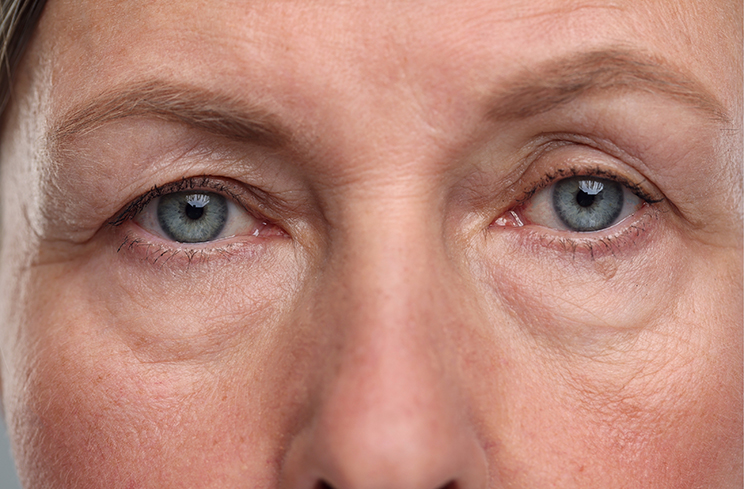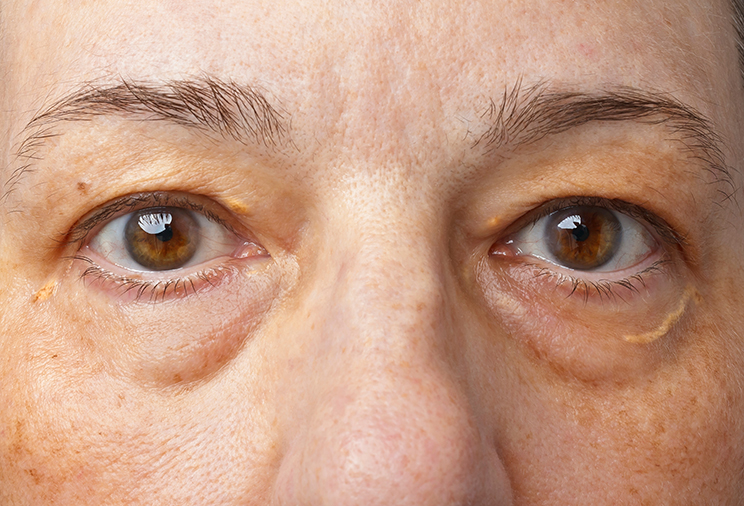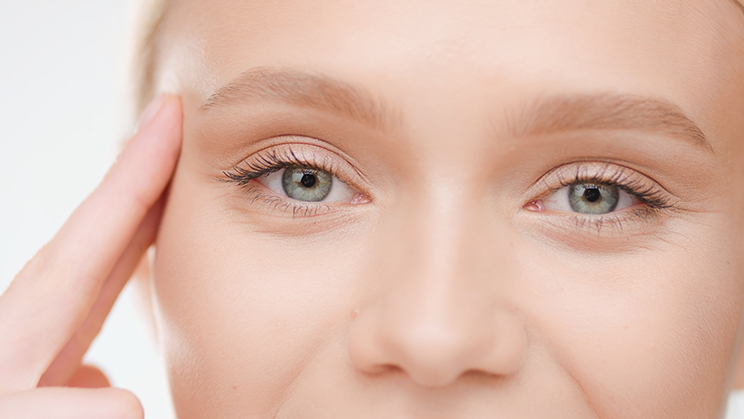Roikkuvat luomet - mistä apu niihin?

Roikkuvat luomet, jotka tunnetaan myös nimillä riippuluomet tai lippaluomet, ovat yleinen vaiva, joka voi vaikuttaa sekä ulkonäköön että päivittäiseen elämänlaatuun. Tämä tila ilmenee, kun yläluomi laskeutuu normaalia alemmas, joko osittain tai peittäen silmän iiriksen täysin. Roikkuvat luomet saattavat johtaa väsähtäneeseen tai alakuloiseen ilmeeseen, vaikka henkilö olisi täysin levännyt ja hyväntuulinen. Vaivan vakavuudesta riippuen se voi olla puhtaasti esteettinen ongelma tai aiheuttaa merkittävää haittaa näkökentälle, jolloin silmän toimintakyky heikkenee.
Kun kyseessä on ptoosi, luomen liike saattaa olla rajoittunut. Tämä voi tehdä yksinkertaisista päivittäisistä tehtävistä, kuten lukemisesta tai auton ajamisesta, haastavia. Joillakin ihmisillä roikkuvat luomet aiheuttavat myös fyysistä epämukavuutta, kuten raskasta tunnetta luomilla tai päänsärkyä, koska kulmakarvoja täytyy jatkuvasti kohottaa paremman näkyvyyden saamiseksi. Ongelma voi esiintyä vain toisessa tai molemmissa silmissä, ja sen vakavuus vaihtelee suuresti. Vaikka ongelma on yleisempi iäkkäämmillä ihmisillä, se voi koskettaa kaikenikäisiä, myös lapsia.
Mistä roikkuvat silmäluomet johtuvat?
Roikkuvien luomien taustalla voi olla monia eri tekijöitä. Ongelman syyt ja taustamekanismit vaihtelevat henkilöstä toiseen, ja usein vaikuttavia tekijöitä on useita.
- Ikääntyminen on yleisin syy riippuluomiin. Ajan myötä silmäluomien iho ohenee ja menettää elastisuuttaan. Lisäksi luomia kannattelevat lihakset heikkenevät, ja niiden sidekudos venyy, mikä johtaa yläluomen laskeutumiseen. Tämä luonnollinen prosessi on osa ikääntymistä, mutta sen ilmeneminen voi vaihdella yksilöllisesti.
- Joissakin tapauksissa riippuluomi johtuu hermoston ongelmista tai lihasten toimintahäiriöistä. Kolmannen asteen hermovauriot tai sairaudet, kuten myasthenia gravis, voivat estää luomia nostavan lihaksen normaalin toiminnan. Hermovauriot voivat syntyä esimerkiksi aivovamman, kasvaimen tai leikkauksen seurauksena.
- Synnynnäinen ptoosi on tila, jossa lapsi syntyy roikkuvan luomen kanssa. Tämä johtuu tavallisesti siitä, että levator-lihas – joka vastaa yläluomen nostamisesta – ei ole kehittynyt kunnolla. Vaikka tila ei aina vaikuta näkökykyyn, se saattaa haitata lapsen silmän kehittymistä normaalisti, jos ongelma jää hoitamatta.
- Silmäalueelle kohdistunut vamma, kuten isku tai leikkauksen jälkeinen komplikaatio, voi johtaa riippuluomiin. Myös silmäluomen toistuva tulehdus tai ihosairaudet voivat heikentää luomen tukirakenteita.

Roikkuvan luomen tunnistaminen
Roikkuvia luomia voidaan tarkastella niiden tyypin, alkuperän ja vaikutusten perusteella. Jokaisessa muodossa on omat erityispiirteensä, jotka vaikuttavat sekä ulkonäköön että näkökykyyn.
- Kulmakarvojen laskeutuminen: Ikääntymisen myötä kulmakarvojen alueen lihasten kimmoisuus heikkenee, mikä johtaa niiden laskeutumiseen. Tämä lisää painetta yläluomille ja aiheuttaa luomien roikkumisen, vaikka varsinaiset luomien lihakset olisivat kunnossa. Tällainen tila kaventaa näkökenttää erityisesti yläosasta.
- Lippaluomi: Lippaluomessa yläluomille kertyy ylimääräistä ihoa, joka muodostaa taitoksen. Tämä tila on yleinen ikääntymisen yhteydessä ja näkyy selvästi, kun silmiä avataan. Vaikka lippaluomi on usein esteettinen ongelma, se voi vakavammissa tapauksissa haitata näkökenttää.
- Riippuluomi (ptoosi): Ptoosissa ongelma koskee itse luomen nostomekanismia. Tämä voi johtua levator-lihaksen heikkoudesta, hermostollisista ongelmista tai rakenteellisista poikkeavuuksista. Ptoosi voidaan jakaa seuraaviin vaiheisiin:
- Lievä ptoosi: Luomi roikkuu hieman, mutta ei estä näkökykyä.
- Kohtalainen ptoosi: Näkökenttä kapenee, ja potilas saattaa kompensoida ongelmaa nostamalla kulmakarvojaan tai kallistamalla päätä.
- Vakava ptoosi: Luomi peittää osan tai koko silmän, aiheuttaen merkittäviä toiminnallisia haittoja.
Näiden lisäksi voidaan erotella synnynnäiset ja hankinnaiset luomien ongelmat. Synnynnäiset muodot johtuvat usein levator-lihaksen alikehittyneisyydestä, kun taas hankinnaiset ongelmat liittyvät ikääntymiseen, sairauksiin tai vammoihin.

Miten saada roikkuvat luomet pois?
- EXION Face: Käyttää kohdennettua ultraääntä ja monopolaarista radiofrekvenssiä ja stimuloi hyaluronihapon, kollageenin ja elastiinin tuotantoa, kiinteyttäen roikkuvaa ihoa tehokkaasti.
- EMFACE: Veitsetön ja moderni facelift-laitehoito ikääntymismuutoksiin hoitaa sekä kasvojen veltostunutta ihoa että lihaksia. Tuloksena on kiinteämpi iho sekä ryppyjen, sibelius- ja nasolabiaalijuonteiden tasoittuminen.
- Botuliinipistokset: Kulmakarvojen laskeutumisesta johtuva roikkuva vaikutus voidaan korjata botoxilla, joka kohottaa kulmakarvoja ja parantaa yleisilmettä.
- EXION Clear RF: Kiinteyttää yläluomen ihoa ja stimuloi kollageenin tuotantoa, jolloin roikkuvat luomet kohoavat luonnollisesti ja katse näyttää virkeämmältä.
- EXION Fractional RF: Mikroneulaushoito uudistaa ja napakoittaa silmäluomen ihoa sisältäpäin, vähentäen roikkuvuutta ja tehden katseesta avoimemman ja nuorekkaamman.
- Mesoterapia ja biorevitalisaatio: Kosteuttavat ja ravitsevat silmäluomen herkkää ihoa, parantaen sen elastisuutta ja hidastaen roikkuvuuden etenemistä, jolloin katse pysyy raikkaampana ja nuorekkaampana.
- Leikkaushoito (blefaroplastia): Silmäluomileikkauksessa poistetaan ylimääräinen iho ja kiristetään lihaksia tai sidekudosta. Tämä on tehokkain ja pitkäaikaisin ratkaisu.
- Ptoosileikkaus: Tämä leikkaus kohdistuu suoraan ptoosiin vaikuttavaan lihakseen, kuten levator-lihakseen, ja auttaa nostamaan luomea takaisin oikealle tasolle.
- Ihonhoito ja laserhoidot: Lievissä tapauksissa erilaiset ihohoidot tai laserhoito voivat parantaa silmäluomen ihoa ja ehkäistä roikkuvuuden pahenemista.
- Fysioterapia: Joissain tapauksissa, kuten neurologisista syistä johtuvassa riippuluomessa, fysioterapia voi vahvistaa silmäluomia liikuttavia lihaksia.
Roikkuvien luomien hoito kannattaa räätälöidä yksilöllisesti, ja oikean hoidon valinta riippuu sekä ongelman syystä että sen vaikutuksista elämänlaatuun.

Yhdistelmähoidot
- EXION™ Face + EMFACE™ -yhdistelmähoito: Tehokas hoitovaihtoehto roikkuvien luomien aiheuttamien esteettisten ja toiminnallisten ongelmien ratkaisemiseksi. EXION™ Face kiinteyttää luomien ihoa ja parantaa sen rakennetta, kun taas EMFACE™ stimuloi lihaksia ja auttaa nostamaan roikkuvia luomia ilman leikkausta. Hoito sopii erityisesti potilaille, jotka haluavat veitsettömän ja kivuttoman ratkaisun roikkuvien luomien hoitoon.
Roikkuvien luomien hoito kannattaa räätälöidä yksilöllisesti, ja oikean hoidon valinta riippuu sekä ongelman syystä että sen vaikutuksista elämänlaatuun.
MESQ®
DoctusPlus Oy:n aputoiminimi
Yritys
DoctusPlus Oy
Y-tunnus
3154088-6
Käyntiosoite
Itämerenkatu 11-13 F, 00180 Helsinki
Puhelin
Sähköposti
Aukioloajat
Ma – Pe 11:00 – 19:00